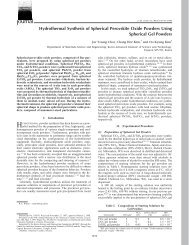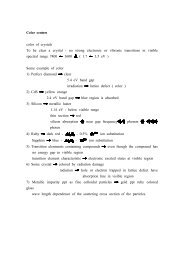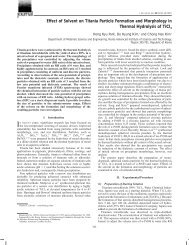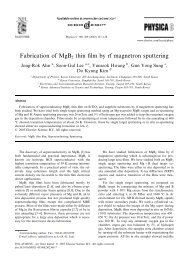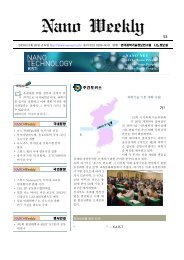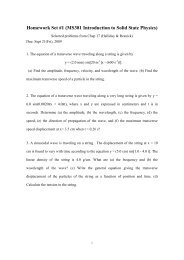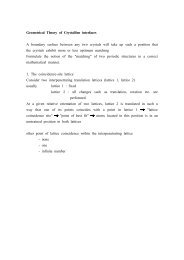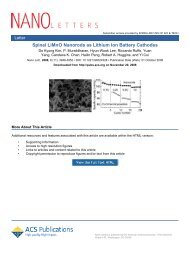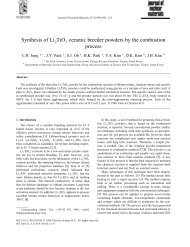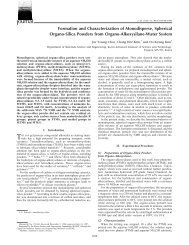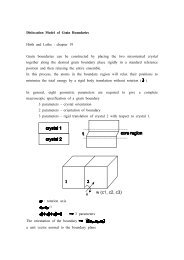Hydrogen storage characteristics of metal oxide doped Al–MCM-41 ...
Hydrogen storage characteristics of metal oxide doped Al–MCM-41 ...
Hydrogen storage characteristics of metal oxide doped Al–MCM-41 ...
You also want an ePaper? Increase the reach of your titles
YUMPU automatically turns print PDFs into web optimized ePapers that Google loves.
appropriately. The TEM micrographs for the <strong>Al–MCM</strong>-<strong>41</strong><br />
and their nickel impregnated samples confirm that the<br />
matrix structure is not modified after nickel impregnation<br />
(image not shown) [22]. The presence <strong>of</strong> both Brønsted<br />
and Lewis acid sites in <strong>Al–MCM</strong>-<strong>41</strong> was confirmed from<br />
pyridine adsorbed FTIR study and the density <strong>of</strong> acid sites<br />
are calculated from the TPD–NH 3 and is presented in<br />
Table 1. It can be clearly seen from the data that the density<br />
<strong>of</strong> acid sites increases by increasing the amount <strong>of</strong> aluminum<br />
in the material.<br />
3.2. <strong>Hydrogen</strong> adsorption<br />
<strong>Hydrogen</strong> <strong>storage</strong> <strong>of</strong> the catalysts is dramatically<br />
increases with increasing specific surface area and pore<br />
volume as per the previous literature [17]. An increase in<br />
surface area can improve the H 2 adsorption properties<br />
because <strong>of</strong> the lack <strong>of</strong> specific interacting sites in the case<br />
<strong>of</strong> carbon nanotubes (CNT) and <strong>metal</strong> organic framework<br />
(MOF) [3]. But, in the case <strong>of</strong> molecular sieves, a possible<br />
link between the pore volume and hydrogen adsorption<br />
property is observed [9]. <strong>Hydrogen</strong> adsorption measurements<br />
<strong>of</strong> the <strong>Al–MCM</strong>-<strong>41</strong> molecular sieves are presented<br />
in Fig. 4. It can be clearly seen that there is a significant<br />
change in hydrogen adsorption, though there is no consid-<br />
Amount <strong>of</strong> <strong>Hydrogen</strong> Adsorbed (wt %)<br />
0.07<br />
0.06<br />
0.05<br />
0.20<br />
0.18<br />
0.16<br />
0.14<br />
0.04<br />
0.12<br />
0.03<br />
0.10<br />
0.02<br />
0.08<br />
0.06<br />
0 50 100 150 200<br />
0.0 1.0 2.0 3.0<br />
Si-to-Al Ratio Amount <strong>of</strong> NiO (wt %)<br />
Amount <strong>of</strong> <strong>Hydrogen</strong> Adsorbed (wt %)<br />
0.2<br />
0.16<br />
0.12<br />
0.08<br />
0.04<br />
0<br />
c<br />
NaY<br />
Al-MCM-<strong>41</strong><br />
a b<br />
Cr2O3/Al-MCM-<strong>41</strong><br />
TiO2/Al-MCM-<strong>41</strong><br />
Fe2O3/Al-MCM-<strong>41</strong><br />
NiO/Al-MCM-<strong>41</strong><br />
Fig. 4. Amount <strong>of</strong> hydrogen adsorbed in <strong>Al–MCM</strong>-<strong>41</strong> (a) with different<br />
Si–Al ratio, (b) amount <strong>of</strong> hydrogen adsorbed in NiO-impregnated Al–<br />
MCM-<strong>41</strong> (25) as a function <strong>of</strong> NiO content. (c) <strong>Hydrogen</strong> adsorption<br />
<strong>characteristics</strong> <strong>of</strong> various <strong>metal</strong> <strong>oxide</strong>s impregnated over <strong>Al–MCM</strong>-<strong>41</strong> (25)<br />
mesoporous materials, compared with commercial NaY zeolite.<br />
S. Ramachandran et al. / Catalysis Communications 8 (2007) 1934–1938 1937<br />
erable change in the pore volume (since <strong>metal</strong> <strong>oxide</strong> is<br />
present in subtle amount) due to the impregnation <strong>of</strong><br />
<strong>metal</strong> <strong>oxide</strong>s, which is in close agreement with Regli<br />
et al., reported that besides a high surface area, a peculiar<br />
framework topology combined with the presence <strong>of</strong> highly<br />
dispersed exposed polarizing species is relevant to increase<br />
the value <strong>of</strong> H 2 uptake [23].<br />
The amount <strong>of</strong> hydrogen adsorbed with respect to aluminum<br />
content in <strong>Al–MCM</strong>-<strong>41</strong> (25, 50, 100 and 200) is correlated<br />
in Fig. 4a. From the graph it can be depicted that the<br />
amount <strong>of</strong> hydrogen adsorbed is proportional to the aluminum<br />
content, which could be due to the increment in the protonic<br />
sites (Brønsted acid sites). From Table 1 it can be<br />
clearly seen that the amount <strong>of</strong> hydrogen adsorbed is not<br />
proportional to the surface area as in the case <strong>of</strong> CNT. This<br />
sorption is sufficient to distort the electronic cloud <strong>of</strong> hydrogen;<br />
as a result the center <strong>of</strong> symmetry <strong>of</strong> hydrogen is<br />
destroyed. Hence, there is a change from higher symmetry<br />
D2h point group to lower symmetry C2v point group. The<br />
Brønsted acidity plays a major role in adsorption capacity,<br />
hence, the divalent nickel is an interesting substitutent for<br />
aluminum in <strong>Al–MCM</strong>-<strong>41</strong>, since its presence in the lattice<br />
position (with tetrahedral coordination) can provide double<br />
negative charges, and a consequent increase in the number <strong>of</strong><br />
Brønsted acid sites. Comparison <strong>of</strong> the <strong>storage</strong> capacity <strong>of</strong><br />
Ni–MCM-<strong>41</strong> with <strong>Al–MCM</strong>-<strong>41</strong> exhibits that the former is<br />
observed to be more capable (0.13 wt%) than the later<br />
(0.07 wt%), which could be due to the more Brønsted acid<br />
sites planted by the Ni 2+ ion.<br />
Researchers have reported that higher uptake can be<br />
achieved due to cationic vibrations at higher temperatures<br />
making the cages more accessible in the ion-exchanged<br />
materials [24]. In the current project, we analyze the<br />
hydrogen adsorption capacity <strong>of</strong> the <strong>metal</strong> <strong>oxide</strong>s such<br />
as Cr2O3, TiO2, Fe2O3 and NiO (3 wt%) <strong>doped</strong><br />
<strong>Al–MCM</strong>-<strong>41</strong> (25), since <strong>metal</strong>s differ in the ability to dissociate<br />
hydrogen. But, due to the confined size <strong>of</strong> the nanomaterials,<br />
the stabilization is difficult in the absence <strong>of</strong><br />
mesopores, they may readily agglomerate to form bulk<br />
particles. Hence, MCM-<strong>41</strong> acts as a better support for<br />
<strong>metal</strong> <strong>oxide</strong> catalysts. The hydrogen dissociation ability<br />
<strong>of</strong> the <strong>metal</strong>s depends on surface structure, morphology<br />
and purity and is independent <strong>of</strong> surface area <strong>of</strong> the <strong>metal</strong><br />
<strong>doped</strong> <strong>Al–MCM</strong>-<strong>41</strong> which is found to be 986.7, 952.3,<br />
973.2, 856.3 and 813.3 m 2 /g for <strong>Al–MCM</strong>-<strong>41</strong> (25),<br />
Cr2O3, TiO2, Fe2O3 and NiO <strong>doped</strong> <strong>Al–MCM</strong>-<strong>41</strong> (25),<br />
respectively. Fig. 4c presents the effect <strong>of</strong> various <strong>metal</strong><br />
<strong>oxide</strong> nanoclusters impregnated on <strong>Al–MCM</strong>-<strong>41</strong> (25).<br />
The graph clearly depicts that there is a significant increment<br />
in the hydrogen <strong>storage</strong> capacity by <strong>metal</strong> <strong>oxide</strong> doping,<br />
which could be due to the quite high adsorption<br />
properties due to high surface free energy <strong>of</strong> the nanodimension<br />
particles. In addition, the excess uptake due to<br />
<strong>metal</strong> <strong>oxide</strong> impregnation could be attributed to hydrogen<br />
adsorption process through a spillover mechanism namely<br />
the dissociation <strong>of</strong> hydrogen on the <strong>metal</strong> phase and subsequent<br />
migration onto the support.



